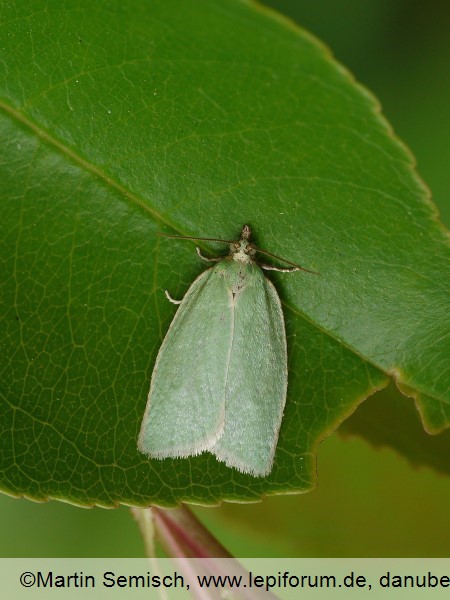Animalia
European oak leaf roller and other leaf rollers
Tortrix viridana and other Tortricidae
Andreja Kavčič
|
|

Fig. 1. A Tortrix viridana adult

Fig. 2. A Tortrix viridana caterpillar

Fig. 3. Tortrix viridana pupa

Fig. 4. A typical sign – a rolled leaf shalter made by the larva

Fig. 5. Defoliation caused by Tortrix viridana larvae
DETECTION PERIOD:
April to June, eggs can be seen on twigs from July to March
DESCRIPTION:
Moths are bicolour. They have grass green thorax and forewings with the wingspan of 18–23 mm, hindwings and the abdomen are grey. They have one generation per year. Adults emerge in May or June. Females lay eggs in pairs on shoots near buds in the crown of oaks and other broadleaved trees. Eggs overwinter. Larvae hatch in spring, when leaves start to grow (April – May). They feed on buds, leaves and flowers for about one month. They are hairless, grey green, with small black tubercles on each body segment and a black to brown head. They feed for about one month and reach about 20 mm in length. The larva rolls the leaf margin into a roll, or folds and ties together more leaves, where it first feeds and later pupates between the leaf folds. Pupa is 8–10 mm long, first green, later dark brown.
HABITAT:
The European oak leaf roller can be found in natural habitats, nurseries, plantations and urban areas. It prefers warm and dry localities. Larvae feed on various broadleaved trees, but the primary hosts are oaks (Quercus spp.).
STATUS:
The European oak leaf roller is widespread in Europe, including the ReFOCUS area, in Asia and northern Africa.
IMPACT:
Larvae feed on buds, leaves and flowers of various broadleaved trees, mainly oaks, and cause defoliation in the spring. Defoliation reduces tree growth and seed production, and renders the host susceptible to other pests and diseases as well as abiotic damage (frost). As the defoliation can be strong, the European oak leaf roller is regarded as one of the most important pests on oaks. Moths regularly occur together with other defoliating insects.
SIMILAR SPECIES:
The European oak leaf roller can be confused with other leaf rollers on broadleaved trees in that they have similar ecology and cause similar damage. Similar damage is caused also by some other defoliating insects. However, characteristic rolling or folding of leaves is a sign for the European oak leaf roller. Moths and larvae of different species can be distinguished by their morphological characteristics.
|